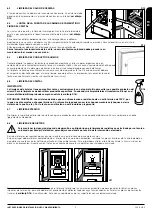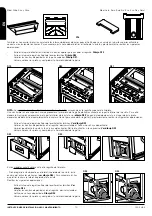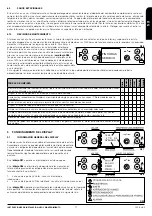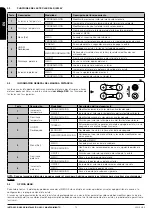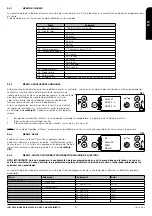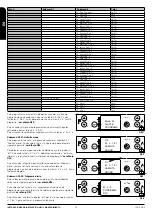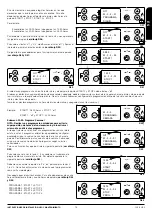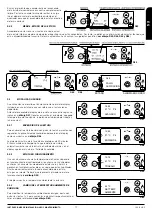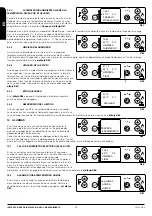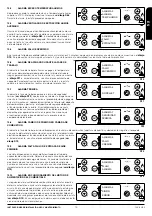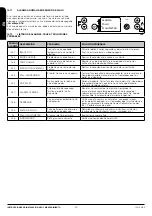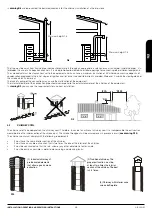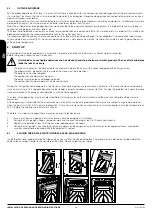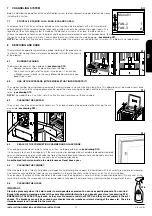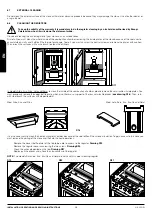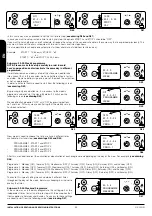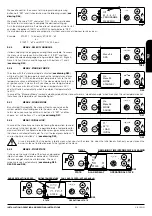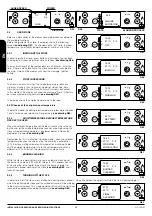
23
•
TEMPORAL POWER LOSS
After a short power loss, the equipment will restart automatically. However in the event of a lack of electricity the stove may give off a small
amount of smoke inside the room for a period of approximately 3-5 minutes.
THIS DOES NOT ENTAIL ANY HEALTH RISK
. This is a reason
why Bronpi advises, whenever possible, to connect the primary air inlet pipe to the exterior of the house in order to assure that
the stove does not give off smokes after a short power loss.
•
ELECTRICAL PROTECTION
The stove is protected against abrupt electricity oscillations through a general fuse placed in the back part. (4A250V
Retarded) (
see drawing D1
).
•
SMOKE OUTLET PROTECTION
The electronic pressure switch blocks the operation of the stove in the event of an abrupt change of the pressure inside the
combustion chamber (door opening, breakdown of the smoke extraction motor, smoke returns, etc). If this happens,
the machine will go into an alarm state (
see drawing D2
).
•
PROTECTION IN THE EVENT OF HIGH TEMPERATURE OF PELLET (80ºC)
In the event of overheating of the internal part of the tank, this device blocks the operation of the machine. The restart
needs to be done manually by an authorised technician (
see drawing D3
).
The restoration of the 80ºC safety device is not included in the warranty unless the technical assistance centre can
demonstrate a faulty component.
•
FLOW SENSOR (OASYS TECHNOLOGY).
Your stove has a flow sensor (
see drawing D4
) placed inside the primary
air suction pipe that detects the proper circulation of combustion air and the
smoke exhaust. In case of insufficient air inlet (due to incorrect smoke outlet or
improper air intake), the sensor sends a “block” signal to the stove.
The OASYS TECHNOLOGY (Optimum Air System) allows a constant
combustion by controlling automatically the draft according to the
characteristics of the flue (curves, length, diameter, etc) and the environmental
conditions (wind, humidity, atmospheric pressure, etc). To that end, the fitter must enter in the technical menu the
geographical altitude of the equipment installation place.
5
INSTALLATION STANDARDS
The way of installing the stove will affect the safety and the proper operation. For this reason, it is recommendable that the installation is
carried out by people who are qualified and informed about the compliance with the installation and safety norms.
If your equipment is not properly installed, it may cause serious damage.
Before the installation, follow the next verifications:
•
Make sure that the floor can sustain the weight of the equipment and make a proper isolation in the case that it is made of flammable
material (wood) or a material that can be affected by a thermal shock (plaster cast, for example).
•
If the equipment is installed on a floor which is not completely refractory or inflammable such as parquet, carpet, etc, it is necessary to
replace this part or introduce a fire-resistant base so that it protrudes out the oven 30 cm. Example of materials include steel flooring,
glass base or any other type of fire-resistant material.
•
Make sure that there is proper ventilation in the place where it is installed (air intake).
•
Avoid the installation in places where there are collective ventilation pipes, hoods with or without extractor, B type gas equipments,
heat pumps or equipments that can cause that the draw is not good if they are used at the same time.
•
Make sure that the smoke duct and the pipes used for the chimney are suitable for the operation of the stove.
•
Make sure that all the equipments have their own smoke duct. Do not use the same duct for various equipments.
•
We recommend that you call your fitter in order to check both the chimney as well as the air flow for the combustion.
5.1
SAFETY MEASURES
During the installation of the equipment, there are risks to be taken into
account, so you should follow the next safety measures:
a.
Keep any flammable or heat sensitive materials (furniture, curtains,
and clothing) at a minimum distance of about 150cm.
b.
If the equipment is installed on a floor which is not completely
refractory or inflammable it is necessary to replace this part or
introduce a fire-resistant base.
c.
Do not place the stove near combustible walls or likely to be
affected by a thermal shock.
d.
The stove should only be used when the ash pan is inserted and the
door closed.
e.
It is recommended to install carbon monoxide detector (CO) in the
room where the equipment is installed.
f.
If you need a longer wire than the provided use it always with an
earthed plug.
g.
Do not install the stove in a bedroom.
h.
The appliance should never be turned on in the presence of
emission of gases or vapours (e.g., linoleum glue, gasoline, etc). Do not place nearby flammable materials.
i.
Solid combustion residues (ashes) should be collected in an airtight container and resistant to fire.
It is necessary to keep a safe distance when they are installed in spaces where materials are susceptible of being flammables, either the
constructions materials or different materials that surround the stove (
see drawing D5
).
D4
D3
D2
D1
FUSE
20 cm
A
B
C
80-120 cm
2
D5
Floor covering
INSTALLATION, OPERATING AND SERVICING INSTRUCTIONS
AIR SERIES
EN
Summary of Contents for Air Series
Page 105: ...104 11 3 NINA FT ...
Page 121: ...120 11 11 SARA NC ...
Page 123: ...122 11 12 EVA FT ...
Page 125: ...124 11 13 EVA NC FT ...
Page 127: ...126 11 14 CORAL FT ...

